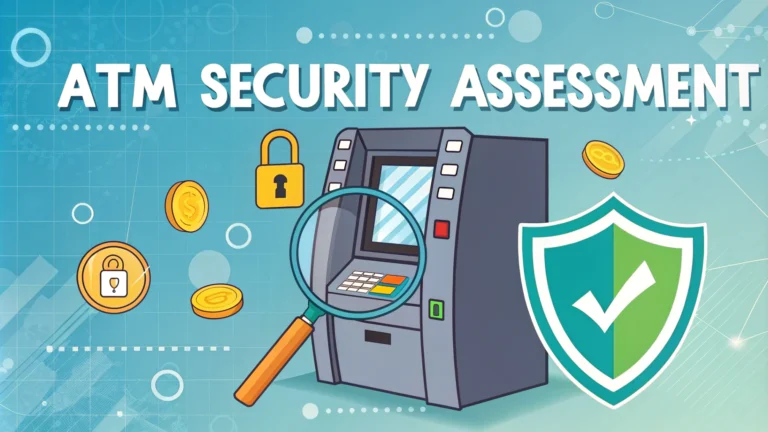ATM security assessment through penetration testing helps identify vulnerabilities in automated teller machines before criminals can exploit them.
Banks and financial institutions must regularly evaluate their ATM networks to protect against evolving cyber threats and physical attacks.
This guide covers essential ATM penetration testing methods, tools, and best practices to strengthen security controls.
Key Areas of ATM Security Testing
- Network infrastructure and communications
- Physical security controls
- Software vulnerabilities
- Hardware tampering risks
- Card reader security
- PIN pad encryption
- Cash dispenser mechanisms
Physical Security Assessment
Examine the ATM’s physical installation, including anchoring, surveillance systems, and anti-tampering mechanisms.
Test resistance against common attack methods like card skimming devices and false fronts.
Evaluate lighting conditions, camera placement, and surrounding environmental security factors.
Network Security Testing
- Check network encryption protocols
- Test firewall configurations
- Analyze communication between ATM and bank servers
- Scan for open ports and services
- Review SSL/TLS implementation
Software Security Analysis
Run vulnerability scans on the ATM operating system and application software.
Test patch management systems and update procedures.
Analyze access control mechanisms and user authentication methods.
Recommended Testing Tools
| Tool Type | Purpose |
|---|---|
| Network analyzers | Wireshark, Tcpdump |
| Vulnerability scanners | Nessus, OpenVAS |
| Penetration testing suites | Metasploit, Core Impact |
| Hardware security tools | Logic analyzers, Protocol analyzers |
Documentation and Reporting
- Document all identified vulnerabilities
- Provide risk ratings for each finding
- Include detailed remediation steps
- Attach evidence and test results
- Recommend security improvements
Regulatory Compliance
Ensure testing meets PCI DSS requirements for ATM security assessments.
Follow local banking regulations and security standards.
Document compliance with relevant ISO/IEC standards.
Next Steps for Enhanced Security
Implement regular security testing schedules based on risk assessments.
Partner with certified ATM security testing providers (PCI QSA Directory).
Stay updated on emerging ATM security threats through resources like ATMIA (ATM Industry Association).
Risk Mitigation Strategies
Develop comprehensive incident response plans specific to ATM security breaches.
Implement real-time monitoring systems to detect and alert suspicious activities.
- Deploy anti-skimming solutions
- Install tamper-resistant card readers
- Use encrypted PIN pad overlays
- Implement motion sensors around ATM units
Employee Training Requirements
Train maintenance staff on security awareness and proper ATM servicing protocols.
Establish clear procedures for responding to security alerts and incidents.
- Physical security protocols
- Social engineering prevention
- Incident reporting procedures
- Emergency response guidelines
Advanced Security Technologies
Biometric Authentication
Implement fingerprint readers and facial recognition systems for enhanced user verification.
AI-Powered Monitoring
Deploy machine learning algorithms to detect unusual transaction patterns and potential threats.
Strengthening ATM Security Posture
Regular penetration testing combined with continuous monitoring forms the foundation of robust ATM security.
Focus on implementing layered security controls covering physical, network, and software aspects.
- Maintain detailed security assessment records
- Update security protocols based on test findings
- Engage with industry security groups
- Adopt emerging security technologies
FAQs
- What is ATM penetration testing and why is it important?
ATM penetration testing is a systematic security assessment of Automated Teller Machines to identify vulnerabilities in hardware, software, network connections, and physical security measures. It’s crucial for preventing financial fraud, protecting customer data, and maintaining compliance with banking security standards. - What are the main areas covered in an ATM security assessment?
The assessment covers physical security, network security, software vulnerabilities, communication protocols, card reader security, PIN pad security, cash dispenser mechanisms, and operating system vulnerabilities. - How often should ATM penetration testing be conducted?
ATM penetration testing should be conducted at least annually or after any significant hardware or software changes. Additionally, testing should be performed when new threat intelligence indicates emerging attack vectors. - What are the common vulnerabilities found during ATM penetration testing?
Common vulnerabilities include outdated operating systems, weak encryption protocols, physical security flaws, network communication vulnerabilities, default passwords, XFS security issues, and compromised card reader mechanisms. - What security standards must be considered during ATM penetration testing?
Key standards include PCI DSS (Payment Card Industry Data Security Standard), ISO 27001, EMV compliance requirements, and specific regional banking security regulations. - What tools are typically used in ATM penetration testing?
Tools include network scanning software, hardware security testing equipment, card reader testing devices, PIN pad analysis tools, encryption testing utilities, and specialized ATM security assessment platforms. - Can ATM penetration testing be conducted remotely?
While some aspects of network security can be tested remotely, comprehensive ATM penetration testing requires physical access to assess hardware security, card readers, and other physical components. - What types of attacks are simulated during ATM penetration testing?
Testing simulates black box attacks, network-based attacks, card skimming attempts, cash trapping, malware injection, communication interception, and physical security breaches. - How are ATM penetration test results documented and reported?
Results are documented in detailed technical reports including vulnerability descriptions, risk levels, proof of concepts, attack scenarios, and specific remediation recommendations for each identified security issue. - What qualifications should ATM penetration testers possess?
Testers should have certifications in penetration testing (CEH, OSCP), banking security experience, knowledge of ATM hardware and software architecture, and understanding of financial security compliance requirements.







